Bhagawan Sri Sathya Sai Baba’s Digvijayam to Tamil Nadu
The Avatar of this Yuga, Bhagawan Sri Sathya Sai Baba, in His infinite mercy, has visited Tamil Nadu innumerable times. He pervades all the Worlds. There is proof of Him manifesting Himself in two or three places at the same time. Very few have however documented the early visits of this Divine incarnation. Many such families have also gone missing with time. Holding onto our dear Lord’s Divine Lotus Feet with utmost humility, we pray to Him to bless us and guide us in writing about the history of His Digvijayam to Tamil Nadu, starting with this Tamil New Year. Along with this, with His blessings, some rare photographs of Bhagawan would also be published.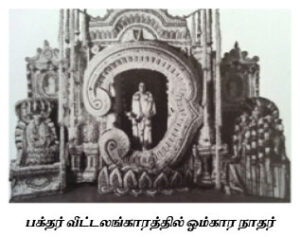
In a Divine discourse, Bhagawan had told that the first incarnation was in Maharashtram and this incarnation was in Madrashtram. In those days, except for the territories of Trivandrum, Cochin, Pudukkottai and Hyderabad, and Pondicherry which was under the French rule, the whole of South India was included in Madras Presidency. That was the reason for Bhagawan saying so. People from many places like Madras (Chennai), Karur and Madurai, when they learnt about a person called ‘Wonder Boy Bala Sai’ who had come as Vaitheeswaran and cured many types of diseases, proceeded towards Puttaparthi in search of a cure for their chronic bodily ailments, mental illnesses and for salvation. Once cured, they told others, and many received Bhakthi as the ultimate medicine for their soul. ‘Keep coming back to our town’ was the request placed by these devotees to Bhagawan.
Where Shaivism and Vaishnavism flourished, through the path shown by the Naayanmaars and Azhwars, the people of Tamil Nadu were immersed in their devotion for God and lived a life of spiritual proximity with God. It was no wonder then, that Bhagawan who is the embodiment of Siva and Sakthi, soon after announcing His Divine incarnation, closely associated Himself with the state of Tamil Nadu.
Our Madhavan appeared in the dream of Karur Ramalakshmi Ammayaar, sister of a very old-time devotee Subramaniya Chettiyar, and asked her to come to Puttaparthi via Penukonda. A Krishna devotee that she was, she went and stayed in Puttaparthi for 40 days and when she returned after being cured of her chronic ailment, Chettiyar too went to Puttaparthi and stayed there.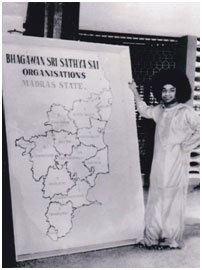
Isn’t God coming in dreams, in reality, a direct appearance? If so, it means that in 1940 itself, Bhagawan came to Karur and called them over. In 1940, soon after the declaration of Avatarhood, for the reason stated above, Sai devotees increased in many places like Karur and Madurai and they kept going to Puttaparthi.
It is told that Bhagawan in His physical form came and stayed in Egmore in 1942. Whatever way one may view it, in His early youth itself, for uplifting Dharma and for His Avataric Mission to be embedded deeply and flourish, Bhagawan set His Divine footprints in Tamil Nadu’s many cities, towns and very small villages where even proper roads were not laid. It would not be an exaggeration to state that it was the deep love and pure devotion of the old-time devotees that attracted this Loving God like a magnet. We should be indebted to them.
An Emperor waging a war with the smaller Kings, one country devouring another, superpowers clashing with each other, are what we know as History. But when one thinks deeply, it is understood that it is only ‘His Story’ that is meaningful History.
The first known visit of Bhagawan to Chennai was in 1942 to Sri Raghava Naidu’s home in Veerasamy Street in Egmore. Many came to participate in the bhajans held there. Called the Volkart Brothers, Parthasarathy Mudaliar and Nagarathinam Mudaliar who lived nearby came and received the Divine grace and blessings. When on a trip to Puttaparthi subsequently, Bhagawan materialized an apple for Parthasarathy Mudaliar and cured him of his long-time asthma problem. His mother was suffering from cataract and was almost blind. Bhagawan placed jasmine flowers on her eyes and tied it, and with this treatment her vision was restored fully.
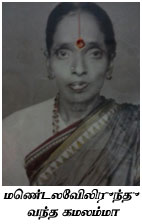 Relatives of Raghava Naidu who had lost everything and returned as refugees from Burma, Kamalamma, elder daughter Chandramma, son-in-law Aalavandhaan Naidu and son Dheenadayalu were staying in his house. Seeing Kamalamma drowned in sorrow as her husband Rajasekara Naidu who was to join them later had not come, Bhagawan described in detail the troubles they met while coming from Mandalay. They were all amazed upon hearing that, as they had not told anything about their escape from Burma and especially Mandalay to Him. They were surprised when He described everything in such detail. What does Bhagawan not know? When Kamalamma asked Him about her husband’s return, Bhagawan replied ‘He has taken up Sanyasa. Forget him.’ He then materialized a green apple, gave it to Kamalamma and asked only her to eat it. He gave a Divine assurance that He would be with her and save her. Once she had the apple, her worries and memories slowly vanished. With Swami’s guidance, Kamalamma got pension from Fort St. George till her last days.
Relatives of Raghava Naidu who had lost everything and returned as refugees from Burma, Kamalamma, elder daughter Chandramma, son-in-law Aalavandhaan Naidu and son Dheenadayalu were staying in his house. Seeing Kamalamma drowned in sorrow as her husband Rajasekara Naidu who was to join them later had not come, Bhagawan described in detail the troubles they met while coming from Mandalay. They were all amazed upon hearing that, as they had not told anything about their escape from Burma and especially Mandalay to Him. They were surprised when He described everything in such detail. What does Bhagawan not know? When Kamalamma asked Him about her husband’s return, Bhagawan replied ‘He has taken up Sanyasa. Forget him.’ He then materialized a green apple, gave it to Kamalamma and asked only her to eat it. He gave a Divine assurance that He would be with her and save her. Once she had the apple, her worries and memories slowly vanished. With Swami’s guidance, Kamalamma got pension from Fort St. George till her last days.
There would have been many more who had met Bhagawan in Raghava Naidu’s house and become devotees.
Source: April 2014, Tamil Sanathana Sarathi Issue.
THE BEAUTY THAT IS SUNDARAM
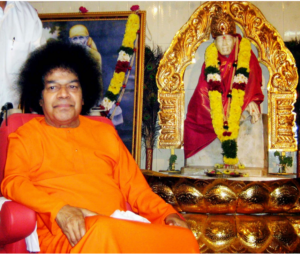 Sundaram is poetry in stone which is a feast for the eye as well as melody for the Soul. With its unique harmony and symmetry of line and curve it is a thing of incomparable Beauty that fills the beholder with sublime Joy. It is not just a stone and mortar building but one sanctified as the Lord’s Home. This 55 feet tall structure was consecrated during the 55th year of the Avatar as His Residence in Chennai. Only the Master Sculptor Himself could have so seamlessly transformed the structure that existed in 1976 into this amazing edifice. The radiance of this spiritual center which is a precious legacy of Bhagawan Sri Sathya Sai Baba draws like a magnet visitors from all over the world. Sundaram is a hub of spiritual, educational and service activities implemented in accordance with Bhagawan’s teachings and guidelines. Spirituality is the thread that runs through all the activities and interlinks them.
Sundaram is poetry in stone which is a feast for the eye as well as melody for the Soul. With its unique harmony and symmetry of line and curve it is a thing of incomparable Beauty that fills the beholder with sublime Joy. It is not just a stone and mortar building but one sanctified as the Lord’s Home. This 55 feet tall structure was consecrated during the 55th year of the Avatar as His Residence in Chennai. Only the Master Sculptor Himself could have so seamlessly transformed the structure that existed in 1976 into this amazing edifice. The radiance of this spiritual center which is a precious legacy of Bhagawan Sri Sathya Sai Baba draws like a magnet visitors from all over the world. Sundaram is a hub of spiritual, educational and service activities implemented in accordance with Bhagawan’s teachings and guidelines. Spirituality is the thread that runs through all the activities and interlinks them.
The divine vibrations that permeate the place imbue one with calm and peace beyond compare after the hurry and worry of a day in the humdrum world. Many seek solace for their trials and tribulations in the serene sanctity of Sundaram. Those with a longing to do service to others find ever so many avenues and since it is spiritualized service, find a great sense of fulfilment. The forlorn and the lonely find a haven that welcomes them in the loving embrace of the Sai family that is ever expanding and inclusive. The budding singers find a salubrious and encouraging atmosphere in which they learn to sing the glory of all forms of God. They thrill in the community of others singing Sangeerthana. They learn to adapt and adopt new disciplines realizing that their singing is a form of Seva since the soulfully sung Bhajan reduces stress and not only provides peace of mind but also elevates the Divine consciousness of those who hear. Many are the variegated outlets for everyone’s talent and need. Sundaram is not only beautiful in form but also unveils the inner beauty of those who associate with it.
Let us have a closer look at this beautiful edifice. The central Gopuram houses Sri Ram, Sita, Lakshmanan and Hanuman and just beneath it is the Graceful Lotus shaped Darshan Balcony. The Yalis and Dwarapalakas on either side of the Vaikunta vasal are traditional and with the artistry of frescoes on either side contribute to the majesty of the facade. The main door is exquisitely carved with intricate designs of Dasa Avatars, Ashtalakshmi, Navagrahas, Sarva Dharma Symbols and Vahanas. It opens into the Bhajan Hall where in the Sanctum Sanctorum there is a larger than life, beautiful photo of Bhagawan Sri Sathya Sai Baba. On either side are two glass doors with pictures of Shiva and Narayana engraved on them. In the front are a Paduka peetam and a throne for Bhagawan. Bhajans are held daily in this hall and on Thursdays and Sundays the renowned Sundaram Bhajan Group is in charge. The Divine vibrations that permeate the hall draw crowds of devotees who immerse themselves in the melodious bhajans and shed tears of Ananda. It draws devotees throughout the day since Sadhana done here is most satisfying to the Soul. Study circles, Disaster Management training camps, Samithi Anniversaries, Balvikas Gurus Meetings and Training, Sevadal camps and meetings, Summer Courses, garland making, making of vibhuthi packets for distribution to devotees after Bhajans, and many more activities are done in this hall during the day time. Adjoining the hall is a Reading Room. As one walks along the corridor one sees a small prayer hall, where too bhajans are held. There are other rooms that cater to the maintenance of Sundaram, for holding meetings, free teaching sessions for Presevadal, Bhajan singers, Vedam, Balvikas, free coaching classes etc.
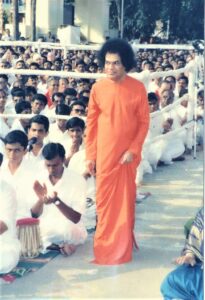
There are three gates, the central gate is in line with the main door. As one walks in through the first gate, to the left on the inner side of the compound wall are embossed Dasavatars and saintly figures of Adi Sankara, Guru Govind Singh, Zoroaster, Buddha and Mahaveer. To the right is the Sri Sai Sundareswar Mandir with its Sthala vriksham, a Bilva tree, a Nandi and Navagrahas in the direct vision of Sri Sai Sundareswar. There is a bigger Nandi situated within a small artificial pond. On either side of the sanctum sanctorum are Vinayaka and Subramanya and along the Praharam are the Trimurthis and Durga Devi. When one reaches the Sundaram building after worshipping at Sri Sai Sundareswar Mandir, one sees a splendid white statue of Lord Shiva and goddess Parvathi. In the frontal corners of the building are Ganesha and Subramanya. To the left of the building is the Sri Shirdi Sai Mandir which houses a marble statue of Sri Shirdi Sai Baba in front of which are His silver Padukas. There is a panchaloka idol used for Abhishekam on Thursdays and special days. In front of the Mandir to its left is a charming marble statue of Sri Venugopalaswami set within a small Kerala style temple structure under an Alexandrian laural tree (punnai). Pujas are done every day both morning and evening to all the deities and on special occasions like Pradosham and Arudra, Abishekam with Ekadasa Rudram is done to Sri Sai Sundareswar as well as Homams on special occasions.
On the first floor there is a veranda that runs from the Lotus balcony to the Jhoola which is frequented by devotees as Meditation centre because of the Stillness and Felt Presence of the Lord who at times swings the Jhoola or blesses some fortunate devotee with a shower of Akshadai. Within are the Lord’s quarters. On the same floor along the rear balcony, Radiosai (Tamil) Recording facility is located.
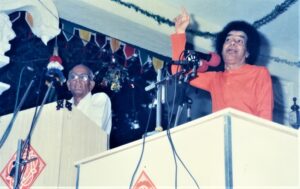 The Books and Publications Division functions in a room next to the Sri Sai Sundareswar Mandir. Beside it are rooms that house offices of Liquid Love (Blood) donation, round the clock helpline service utilizing a data bank of volunteers, Sanathana Sarathi, and Mobile Hospital. Doctors and Sevadal do medical seva by taking the Mobile Hospital bus which is fully furnished with diagnostic facilities to distant places which lack medical facilities. Free medicines are provided to the patients after diagnosis by the team of specialist doctors and follow up treatment is done on the next trip. Most importantly, they attend to the preventive aspect by spending time advising the patients on health and hygiene as well as awareness about the nutritional value of easily available vegetables and sunlight in particular. Since there is a tie-up with local hospitals and Government hospitals there is referral service for next level of treatment. Sundaram organizes and provides immediate relief to those affected by calamities and disasters. Amirtha Kalasam consisting of basic necessities is humbly offered to those in need to tide over their difficult times. All Samithi members feel Sundaram to be their home and hence involve themselves eagerly with whatever service that is required. In order to maintain regularity, Rosters are made for the different Samithis to take up duties in rotation.
The Books and Publications Division functions in a room next to the Sri Sai Sundareswar Mandir. Beside it are rooms that house offices of Liquid Love (Blood) donation, round the clock helpline service utilizing a data bank of volunteers, Sanathana Sarathi, and Mobile Hospital. Doctors and Sevadal do medical seva by taking the Mobile Hospital bus which is fully furnished with diagnostic facilities to distant places which lack medical facilities. Free medicines are provided to the patients after diagnosis by the team of specialist doctors and follow up treatment is done on the next trip. Most importantly, they attend to the preventive aspect by spending time advising the patients on health and hygiene as well as awareness about the nutritional value of easily available vegetables and sunlight in particular. Since there is a tie-up with local hospitals and Government hospitals there is referral service for next level of treatment. Sundaram organizes and provides immediate relief to those affected by calamities and disasters. Amirtha Kalasam consisting of basic necessities is humbly offered to those in need to tide over their difficult times. All Samithi members feel Sundaram to be their home and hence involve themselves eagerly with whatever service that is required. In order to maintain regularity, Rosters are made for the different Samithis to take up duties in rotation.
Sundaram building is accessible to even those who are mobility challenged. Sundaram can be termed as a ‘Green Building’.
Sundaram is easily reachable by road and rail. The nearest MRTS station is the Greenways Station within a walking distance.
Address: 7, Sundaram Salai, Raja Annamalai puram, Chennai – 60028.
Sai Sruthi
Sai Sruti is one of the Ashrams of Bhagawan Sri Sathya Sai Baba and in terms of the number of days He had stayed anywhere, it is next only to Prasanthi Nilayam and Brindavan. It is situated in Kodaikanal near the lake. The altitude of Kodaikanal is 2, 133 metres and the highest temperature is less than twenty degrees centigrade and thus a very pleasant place, particularly in summer. It is 115. 6 kms from Madurai. During the burning heat of summer months Puttaparthi is sizzling hot and devotees of Bhagawan Sri Sathya Sai Baba who are from various parts of the country and various places around the world find Puttaparthi too, too hot. For their sake, Bhagawan shifts to Brindavan, Ooty and Kodaikanal during those months.
Normally the season for tourists in Kodaikanal begins in May depending on the water situation. When Bhagawan started coming to Kodaikanal, devotees began congregating and the economy of the hill town improved vastly. Bhagawan’s coming to Kodaikanal saw the season advance to April and the place was buzzing with devotees from all over the world. In the meantime Bhagawan asked for a guest house to be built in the land that was gifted to the Central Trust by a long time devotee in 1983 since there was not enough space for the devotees to assemble. The guesthouse set in sylvan surroundings was ready by May 1986.
Bhagawan and a few devotees started from Brindavan in a convoy of cars on 18th June 1986, while a busload of students too were coming at the express invitation of Bhagawan. On the 19th Bhagawan entered the Mandir after cutting the ribbon as bhajans were sung by the students. The students were accommodated on the first floor next to the living room of their Lord. They were thrilled but more was to follow. Bhagawan sat on a chair surrounded by the students and devotees like Col. Joga Rao, Sri. Indulal Shah, Smt. Ratanlal, Sri. Srinivasan, Smt. Vidya Srinivasan, Sri. Narasimhachari, Sri. Mohandas Naidu. Bhagawan asked for suggestions for naming the new Mandir. Not being satisfied with the suggestions, He said, “the abode in Brindavan is Trayee Brindavan representing the three Vedas. Let us name this Sai Sruti”. He asked the students to chant Vedic Hymns and thus the place resounded with Sruti! After that Bhagawan gave a discourse on the fundamental message of the Vedas. The sessions with the Lord were intellectually stimulating and spiritually elevating. Sai Sruti saw many additions and alterations. He visited almost every year bringing with Him students and those who worked in His Institutions. It was a continuous festival of joy. They sang songs to their Lord, presented skits and there were quiz sessions, Burra Kathas, and speeches. Bhagawan blessed them with many discourses, and many a time illustrated them with materialisations. A bliss filled silence pervaded the place and every second offered life lessons to those who stayed there. Wherever Bhagawan is, there are always celebrations of festivals such as Sri Rama Navami, Easwaramma Day, Trayee Day, Tamil New Year Day, Vishu etc. On such days Narayana seva as well as distribution of clothes and blankets are done for the destitute and the needy. Bhagawan would lovingly send the students to buy from the Tibetan refugees and the hawkers advising the students to never bargain but be generous. The town thrived during the Sai Season. Kodaikanal people always looked forward to His visits since Bhagawan always exuded love and compassion. There was vast space for devotees to assemble and for distribution of clothes to the needy. Devotees who gathered there had very close Darshans and they found their Lord much more accessible, relaxed with more scope for interactions. Generally, almost half the number of devotees who gathered around Bhagawan was overseas devotees. Swami would walk amidst them talking with many while collecting letters. Vibhuthi and other materialisations were an everyday occurrence. Bhagawan’s last visit to this beautiful ashram surrounded by colourful flowers was in 2009 when a statue of Mother Easwaramma was installed.
A Samithi functions at Sai Sruti. The bhajan Hall is open from 7 am to 6 pm. Bhajans are held in the mornings between 09:00 and 09:30 am and in the evenings between 04:30 and 5:00pm. On Thursdays and Sundays evening bhajans are between 4 and 5 pm. On Maha Sivarathri, Easwaramma Day, Guru Purnima and Bhagawan’s birthday, Narayana seva and Vastradhan are performed for around 5000 persons. Medical camps are done at Sai Sruti two times annually and more if needed. There is a Rural Vocational training centre where Computer training and training in tailoring is given. A museum of articles used by Bhagawan are treasured and kept on display for all devotees who visit Sai Sruti. A permanent exhibition of photos of Bhagawan’s visits to Tamil Nadu is something devotees are drawn to every time they visit. Each of these priceless photos is a gem that has caught Unconditional Love in action in some distant corner of Tamilnadu.
Recently renovation on a massive scale has been done. The availability of fully furnished rooms and active kitchen makes it possible to hold conferences and Sadhana camps at district level. Training camps for each wing of the Sri Sathya Sai Seva Organisation are being held. A three day All India Youth Conference was held last year which was addressed by the All India President Sri Nimish Pandia. An All India Office bearers meeting was also held here. A training camp for Sri Sathya Sai Vidya Vahini was an annual feature. As directed by Bhagawan, service is being continually done to the underprivileged in distant villages in Kodaikanal. Every month a unique Mother and Child care kits numbering 40-50 are distributed to the needy. Anganwadis have been renovated by an NGO who along with the local Samithi has been actively making the unemployed employable by training them in skills and also teaching them Values. Bhagawan has said that service only when spiritualized can be termed Seva. He wanted Seva that would not only uplift economically but bring about a Spiritual Renaissance.
Anandha Nilayam
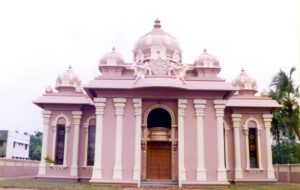 In the early years of Sri Sathya Sai Baba’s Advent, Baba used to travel extensively, mainly in the southern part of the country, especially the present Tamil Nadu districts. The city of Madurai famous for its ancient temple of Divine Mother Meenakshi, was a blessed witness to such visits on several occasions. Baba had laid foundation to build a township to be developed in Madurai in the 1960s. Ultimately, a colony of residential buildings came up over this site. This colony is now known as ‘Sri Sathya Sai Nagar’.
In the early years of Sri Sathya Sai Baba’s Advent, Baba used to travel extensively, mainly in the southern part of the country, especially the present Tamil Nadu districts. The city of Madurai famous for its ancient temple of Divine Mother Meenakshi, was a blessed witness to such visits on several occasions. Baba had laid foundation to build a township to be developed in Madurai in the 1960s. Ultimately, a colony of residential buildings came up over this site. This colony is now known as ‘Sri Sathya Sai Nagar’.
As years passed by, the awareness of Baba’s divine message and universal teachings of love and service, began to capture the hearts of the people of Madurai. Many centres for organising service and spiritual activities emerged in various places. This situation prompted one of the prominent citizen of the town and a devotee of Baba, Sri Subramaniya Chettiar to conceive the idea of a divine abode for Sri Sathya Sai Baba at Madurai for His stay and also provide convenience for the thousands who would gather to participate in various activities and spiritual programmes. In September 1998, Baba very graciously showed His green signal for the commencement of the Ananda Nilayam construction at Madurai. The construction was completed within 5 months with the dedicated efforts of the devotees.
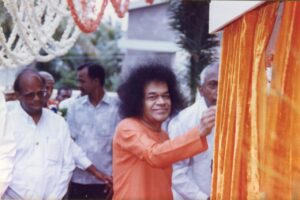 Baba visited Madurai on the 22nd April 1999, and consecrated the Sri Sathya Sai Ananda Nilayam. A Paduka Peetham (pedestal) with design of a Paduka (sacred foot impression) inscribed on black granite has been installed in Ananda Nilayam. During a Divine visit, Baba consecrated the granite Peetham for about 15 minutes by standing on it.
Baba visited Madurai on the 22nd April 1999, and consecrated the Sri Sathya Sai Ananda Nilayam. A Paduka Peetham (pedestal) with design of a Paduka (sacred foot impression) inscribed on black granite has been installed in Ananda Nilayam. During a Divine visit, Baba consecrated the granite Peetham for about 15 minutes by standing on it.
Almost every summer since 1999, on His way to Kodaikanal, Baba visited Ananda Nilayam. True to its name, this shrine of selfless Love of Baba brings-forth ananda (bliss) to thousands of devotees who gather there.

 Help Desk Number:
Help Desk Number:
 Bird’s eye view of activities at Sundaram
Bird’s eye view of activities at Sundaram